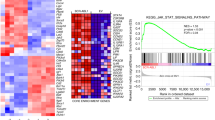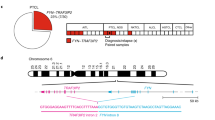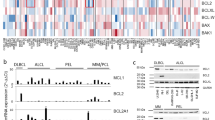Abstract
One of the characteristic features of anaplastic lymphoma kinase (ALK)+, anaplastic large cell lymphoma (ALK+ALCL) is the constitutive activation of signal transducers and activators of transcription-3 (STAT3), a defect believed to be important for the pathogenesis of these tumors. In this report, we describe the existence of an autocrine stimulatory loop involving interleukin-22 (IL-22) that contributes to STAT3 activation and tumorigenicity of ALK+ALCL. The IL-22 receptor, a heterodimer composed of IL-22R1 and IL-10R2, was expressed in all ALK+ALCL cell lines and tumors examined. The expression of IL-22R1 in ALK+ALCL is aberrant, as this protein is absent in benign lymphocytes. Although ALK+ALCL cells produce endogenous IL-22, addition of recombinant IL-22 to ALK+ALCL cell lines significantly increased STAT3 activation, cell proliferation and colony formation in soft agar. Opposite biological effects were observed in cells treated with recombinant IL-22 binding protein (a naturally occurring IL-22 decoy) or IL-22-neutralizing antibody. Nucleophosmin (NPM)-ALK, the characteristic fusion gene oncoprotein expressed in ALK+ALCL, directly contributes to the aberrant expression of IL-22R1, as transfection of NPM-ALK in Jurkat cells-induced IL-22R1 expression and IL-22-mediated STAT3 activation. To conclude, for the first time, we demonstrate the importance of the IL-22 autocrine pathway in a lymphoid malignancy, and reveal yet another novel function of NPM-ALK.
This is a preview of subscription content, access via your institution
Access options
Subscribe to this journal
Receive 12 print issues and online access
$259.00 per year
only $21.58 per issue
Buy this article
- Purchase on Springer Link
- Instant access to full article PDF
Prices may be subject to local taxes which are calculated during checkout





Similar content being viewed by others
References
Morris SW, Kirstein MN, Valentine MB, Dittmer KG, Shapiro DN, Saltman DL et al. Fusion of a kinase gene, ALK, to a nucleolar protein gene, NPM, in non-Hodgkin's lymphoma. Science 1994; 263: 1281–1284.
Moser B, Wolf M, Walz A, Loetscher P . Chemokines: multiple levels of leukocyte migration control. Trends Immunol 2004; 25: 75–84.
Shiota M, Fujimoto J, Semba T, Satoh H, Yamamoto T, Mori S . Hyperphosphorylation of a novel 80 kDa protein-tyrosine kinase similar to Ltk in a human Ki-1 lymphoma cell line, AMS3. Oncogene 1994; 9: 1567–1574.
Slupianek A, Nieborowska-Skorska M, Hoser G, Morrione A, Majewski M, Xue L et al. Role of phosphatidylinositol 3-kinase-Akt pathway in nucleophosmin/anaplastic lymphoma kinase-mediated lymphomagenesis. Cancer Res 2001; 61: 2194–2199.
Amin HM, McDonnell TJ, Ma Y, Lin Q, Fujio Y, Kunisada K et al. Selective inhibition of STAT3 induces apoptosis and G(1) cell cycle arrest in ALK-positive anaplastic large cell lymphoma. Oncogene 2004; 23: 5426–5434.
Zamo A, Chiarle R, Piva R, Howes J, Fan Y, Chilosi M et al. Anaplastic lymphoma kinase (ALK) activates Stat3 and protects hematopoietic cells from cell death. Oncogene 2002; 21: 1038–1047.
Bromberg JF, Wrzeszczynska MH, Devgan G, Zhao Y, Pestell RG, Albanese C et al. Stat3 as an oncogene. Cell 1999; 98: 295–303.
Burke WM, Jin X, Lin HJ, Huang M, Liu R, Reynolds RK et al. Inhibition of constitutively active Stat3 suppresses growth of human ovarian and breast cancer cells. Oncogene 2001; 20: 7925–7934.
Catlett-Falcone RLT, Oshiro MM, Turkson J, Levitzki A, Savino R, Ciliberto G et al. Constitutive activation of Stat3 signaling confers resistance to apoptosis in human U266 myeloma cells. Immunity 1999; 10: 105–115.
Levy DE, Lee CK . What does Stat3 do? J Clin Invest 2002; 109: 1143–1148.
Chiarle R, Simmons WJ, Cai H, Dhall G, Zamo A, Raz R et al. Stat3 is required for ALK-mediated lymphomagenesis and provides a possible therapeutic target. Nat Med 2005; 11: 623–629.
Amin HM, Medeiros LJ, Ma Y, Feretzaki M, Das P, Leventaki V et al. Inhibition of JAK3 induces apoptosis and decreases anaplastic lymphoma kinase activity in anaplastic large cell lymphoma. Oncogene 2003; 22: 5399–5407.
Cussac D, Greenland C, Roche S, Bai RY, Duyster J, Morris SW et al. Nucleophosmin-anaplastic lymphoma kinase of anaplastic large-cell lymphoma recruits, activates, and uses pp60c-src to mediate its mitogenicity. Blood 2004; 103: 1464–1471.
Bonvini P, Gastaldi T, Falini B, Rosolen A . Nucleophosmin-anaplastic lymphoma kinase (NPM-ALK), a novel Hsp90-client tyrosine kinase: down-regulation of NPM-ALK expression and tyrosine phosphorylation in ALK(+) CD30(+) lymphoma cells by the Hsp90 antagonist 17-allylamino,17-demethoxygeldanamycin. Cancer Res 2002; 62: 1559–1566.
Dumoutier L, Louahed J, Renauld JC . Cloning and characterization of IL-10-related T cell-derived inducible factor (IL-TIF), a novel cytokine structurally related to IL-10 and inducible by IL-9. J Immunol 2000; 164: 1814–1819.
Wolk K, Kunz S, Asadullah K, Sabat R . Cutting edge: immune cells as sources and targets of the IL-10 family members? J Immunol 2002; 168: 5397–5402.
Wolk K, Witte E, Reineke U, Witte K, Friedrich M, Sterry W et al. Is there an interaction between interleukin-10 and interleukin-22? Genes Immun 2005; 6: 8–18.
Wolk K, Witte E, Wallace E, Docke WD, Kunz S, Asadullah K et al. IL-22 regulates the expression of genes responsible for antimicrobial defense, cellular differentiation, and mobility in keratinocytes: a potential role in psoriasis. Eur J Immunol 2006; 36: 1309–1323.
Dumoutier L, Lejeune D, Colau D, Renauld JC . Cloning and characterization of IL-22 binding protein, a natural antagonist of IL-10-related T cell-derived inducible factor/IL-22. J Immunol 2001; 166: 7090–7095.
Gruenberg BH, Schoenemeyer A, Weiss B, Toschi L, Kunz S, Wolk K et al. A novel, soluble homologue of the human IL-10 receptor with preferential expression in placenta. Genes Immun 2001; 2: 329–334.
Kotenko SV, Izotova LS, Mirochnitchenko OV, Esterova E, Dickensheets H, Donnelly RP et al. Identification of the functional interleukin-22 (IL-22) receptor complex: the IL-10R2 chain (IL-10Rbeta) is a common chain of both the IL-10 and IL-22 (IL-10-related T cell-derived inducible factor, IL-TIF) receptor complexes. J Biol Chem 2001; 276: 2725–2732.
Lejeune D, Dumoutier L, Constantinescu S, Kruijer W, Schuringa JJ, Renauld JC . Interleukin-22 (IL-22) activates the JAK/STAT, ERK, JNK, and p38 MAP kinase pathways in a rat hepatoma cell line. Pathways that are shared with and distinct from IL-10. J Biol Chem 2002; 277: 33676–33682.
Gurney AL . IL-22, a Th1 cytokine that targets the pancreas and select other peripheral tissues. Int Immunopharmacol 2004; 4: 669–677.
Lamant L, De Reynies A, Duplantier MM, Rickman DS, Sabourdy F, Giuriato S et al. Gene expression profiling of systemic anaplastic large cell lymphoma reveals differences depending on ALK status and two distinct morphological ALK+ subtypes. Blood 2007; 109: 2156–2164.
Dien J, Amin HM, Chiu N, Wong W, Frantz C, Chiu B et al. Signal transducers and activators of transcription-3 up-regulates tissue inhibitor of metalloproteinase-1 expression and decreases invasiveness of breast cancer. Am J Pathol 2006; 169: 633–642.
Han Y, Amin HM, Frantz C, Franko B, Lee J, Lin Q et al. Restoration of shp1 expression by 5-AZA-2′-deoxycytidine is associated with downregulation of JAK3/STAT3 signaling in ALK-positive anaplastic large cell lymphoma. Leukemia 2006; 20: 1602–1609.
Xie MH, Aggarwal S, Ho WH, Foster J, Zhang Z, Stinson J et al. Interleukin (IL)-22, a novel human cytokine that signals through the interferon receptor-related proteins CRF2-4 and IL-22R. J Biol Chem 2000; 275: 31335–31339.
Kotenko SV . The family of IL-10-related cytokines and their receptors: related, but to what extent? Cytokine Growth Factor Rev 2002; 13: 223–240.
Brand S, Dambacher J, Beigel F, Zitzmann K, Heeg MH, Weiss TS et al. IL-22 mediated liver cell regeneration is abrogated by SOCS-1/3 overexpression in vitro. Am J Physiol Gastrointest Liver Physiol 2007; 292: G1019–G1028.
Weber GF, Gaertner FC, Erl W, Janssen KP, Blechert B, Holzmann B et al. IL-22-mediated tumor growth reduction correlates with inhibition of ERK1/2 and AKT phosphorylation and induction of cell cycle arrest in the G2-M phase. J Immunol 2006; 177: 8266–8272.
Nagalakshmi ML, Rascle A, Zurawski S, Menon S, de Waal Malefyt R . Interleukin-22 activates STAT3 and induces IL-10 by colon epithelial cells. Int Immunopharmacol 2004; 4: 679–691.
Han Y, Amin HM, Franko B, Frantz C, Shi X, Lai R . Loss of SHP1 enhances JAK3/STAT3 signaling and decreases proteosome degradation of JAK3 and NPM-ALK in ALK+ anaplastic large-cell lymphoma. Blood 2006; 108: 2796–2803.
Amin HM, Lai R . Pathobiology of ALK+ anaplastic large-cell lymphoma. Blood 2007; 110: 2259–2267.
Zhang Q, Raghunath PN, Xue L, Majewski M, Carpentieri DF, Odum N et al. Multilevel dysregulation of STAT3 activation in anaplastic lymphoma kinase-positive T/null-cell lymphoma. J Immunol 2002; 168: 466–474.
Andoh A, Zhang Z, Inatomi O, Fujino S, Deguchi Y, Araki Y et al. Interleukin-22, a member of the IL-10 subfamily, induces inflammatory responses in colonic subepithelial myofibroblasts. Gastroenterology 2005; 129: 969–984.
Ikeuchi H, Kuroiwa T, Hiramatsu N, Kaneko Y, Hiromura K, Ueki K et al. Expression of interleukin-22 in rheumatoid arthritis: potential role as a proinflammatory cytokine. Arthritis Rheum 2005; 52: 1037–1046.
Du L, Lyle CS, Obey TB, Gaarde WA, Muir JA, Bennett BL et al. Inhibition of cell proliferation and cell cycle progression by specific inhibition of basal JNK activity: evidence that mitotic Bcl-2 phosphorylation is JNK-independent. J Biol Chem 2004; 279: 11957–11966.
Nagata Y, Todokoro K . Requirement of activation of JNK and p38 for environmental stress-induced erythroid differentiation and apoptosis and of inhibition of ERK for apoptosis. Blood 1999; 94: 853–863.
Ono K, Han J . The p38 signal transduction pathway: activation and function. Cell Signal 2000; 12: 1–13.
Marzec M, Kasprzycka M, Liu X, Raghunath PN, Wlodarski P, Wasik MA . Oncogenic tyrosine kinase NPM/ALK induces activation of the MEK/ERK signaling pathway independently of c-Raf. Oncogene 2007; 26: 813–821.
Acknowledgements
This study is supported by operating research grants from the Alberta Cancer Foundation, Canadian Cancer Society/National Cancer Institute of Canada and the Canadian Institute for Health Research awarded to RL. PG is a research fellow supported by the Lymphoma Foundation of Canada. MA is a clinical research fellowship supported by the Canadian Cancer Society and the National Cancer Institute of Canada. HMA is a recipient of the University of Texas MD Anderson Physician Scientist Program Award and also a K08 award from the National Cancer Institute (CA114395).
Author information
Authors and Affiliations
Corresponding author
Rights and permissions
About this article
Cite this article
Bard, J., Gelebart, P., Anand, M. et al. Aberrant expression of IL-22 receptor 1 and autocrine IL-22 stimulation contribute to tumorigenicity in ALK+ anaplastic large cell lymphoma. Leukemia 22, 1595–1603 (2008). https://doi.org/10.1038/leu.2008.129
Received:
Revised:
Accepted:
Published:
Issue Date:
DOI: https://doi.org/10.1038/leu.2008.129
Keywords
This article is cited by
-
IL-2/IL-2R signaling and IL-2Rα-targeted therapy in anaplastic large cell lymphoma
Die Pathologie (2022)
-
Interleukin-22 and connective tissue diseases: emerging role in pathogenesis and therapy
Cell & Bioscience (2021)
-
Immunobiology of T Cells in Sjögren’s Syndrome
Clinical Reviews in Allergy & Immunology (2021)
-
Dependency on the TYK2/STAT1/MCL1 axis in anaplastic large cell lymphoma
Leukemia (2019)
-
Clinicopathologic implication of microRNA-197 in diffuse large B cell lymphoma
Journal of Translational Medicine (2018)



